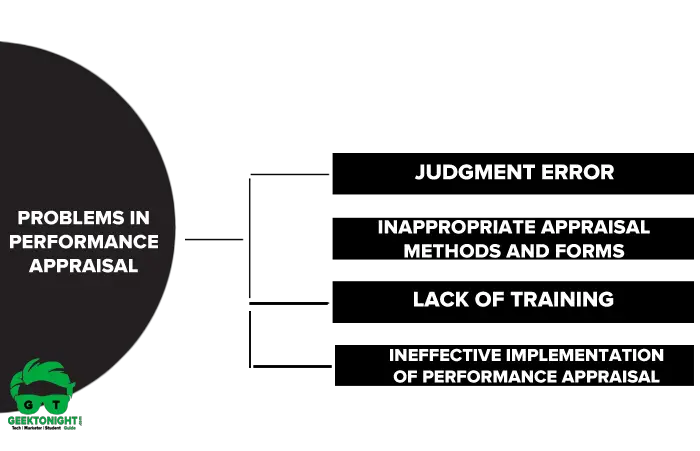There are various problems and challenges faced in Performance appraisal. Broadly, problems in performance appraisal are categorized into 4 types:
- Judgment Error
- Inappropriate appraisal methods and forms
- Lack of training
- Ineffective implementation of performance appraisal.

Table of Content
Judgment Error
Since the rating of an employee depends on the opinion and perception about him held by his senior or supervisors it may suffer from subjectivity and bias in many forms which are discussed below:
Halo effect
Under halo effect influence if the rater aptly rates the employee as excellent in one quality he tends to further give him higher than deserved rating in other qualities.
Example, excellent scoring in communication skills might influence the rater to give excellent scoring in coordination skills even if the employee is not so good at it.
Horn effect
Horn effect is the reverse of the Halo effect. In case the employee is a poor performer of low ranker in a certain quality that might influence the rater to give him lower than deserved rating in other qualities.
Example, the employee rarely smiles so he does not possess good interpersonal skills as well.
Influence of first impression
At times the first impression of the candidate in the appraiser’s mind lasts forever and in turn influences his opinion and ratings for all the subsequent behaviour of the candidate.
Leniency
Leniency error leaves the entire performance appraisal exercise redundant. As the appraiser is reluctant in giving low scores to the employees depending on his state of mind at the time of appraisal. He might hesitate to rank an employee very low on the scale in case the others have achieved a high ranking.
Central tendency
In order to play safe and in the fear of being disliked by their subordinates, managers might end up rating all the employees as average performers regardless of the differences in their performance levels.
Stereotyping
Under Stereotyping, the supervisors may end up generalizing the behaviour of the subordinates on the basis of their age, sex, religion, caste etc. They have a preconceived notion about such images and they might end up overestimating or underestimating the employees.
Recency effect
The most recent behaviour of the employee is so fresh in the mind of the appraiser that it influences his rating for the entire evaluation period.
Consequence of appraisal
If a poor appraisal result leads to damaging the career of the employee that appraiser may refrain himself from doing so.
Inappropriate Appraisal Methods and Forms
The methodology used and the forms filled for the appraisal of the employee impacts the effectiveness of the performance appraisal to a great extent.
The forms may be too vague, long and complex. It might cover areas that are not important criteria for the job in question etc.
Lack of Training
The appraiser might not be properly trained to conduct an effective performance appraisal. He might not possess a sense of proper judgment or decision making skills or suffer from low confidence and poor communication skills.
Ineffective Implementation of Performance Appraisal
When the rater provides feedback about the employee after a thorough performance appraisal process, it might not be well accepted by the management.
If a low rating by the rater is perceived as a negative sign of failure at the part of the rater of discontented employees the rater might lose interest in the performance appraisal of the employees and might award them satisfactory ratings despite their poor performance.
To avoid such situations the rater’s immediate supervisor must approve the rating so that the management gains confidence in the feedback.
Key Takeaway
Halo Effect: A judgment error in which the rater aptly rates the employee as excellent in one quality tends to further give him higher than deserved rating in other qualities l Horn Effect: This is the reverse of
Halo Effect: Low rank in a certain quality of the employee might influence the rater to give him lower than deserved rating in other qualities.
Central Tendency: A form of judgment error during performance appraisal in which managers might end up rating all the employees as average in order to play safe and in the fear of being disliked by his subordinates.
Recency Effect: Refers to the error in judgment during performance appraisal where the most recent behaviour of the employee is so fresh in the mind of the appraiser that it influences his rating for the entire evaluation period.
Trait Based Method: It adopts a qualitative approach towards performance appraisal that involves the measurement of different traits and qualities of the employee, the behaviour they adopt while performing a job is evaluated.
Result Oriented Method: Under the result-oriented method of appraisal, the employee’s performance is studied and examined both in terms of quality and quantity.
Reference
- T. V. Rao, “Appraising and Developing Managerial Performance“, Excel Books, New Delhi, 1999.
- D. Grote, “Performance Appraisal Reappraised,’’ Harvard Business Review, Jan- Feb 2000.
- K. R. Murphy, J. Cleveland, “Performance Appraisal”, Boston, M. A: Allyn & Bacon, 1991.
- Scott Snell and G. Bohlander, “Human Resource Management”, Cenpager, New Delhi, 2007.
Go On, Share article with Friends
Did we miss something in Human Resource Management Tutorial? Come on! Tell us what you think about our article on Problems in Performance Appraisal in the comments section.
Human Resources Tutorial
(Click on Topic to Read)





